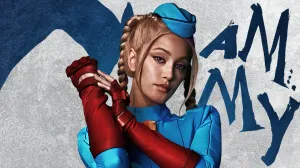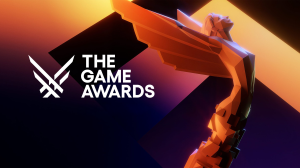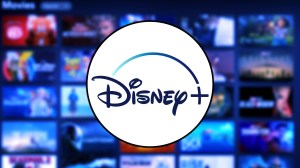Overwatch 2 has rolled out one of its biggest update reveals since the launch of the game
today, with the development team behind the hero shooter teasing what’s to come for the title throughout 2025. To make things even more exciting, it will all start in just a few short days when Overwatch 2 Season 15: Honor & Glory, kicks off on Tuesday, February 18th. ComicBook was present at the Blizzard campus to learn more about what’s coming in Overwatch 2 this year, including getting new details from the development team about what players can expect along with this fresh announcements.
Videos by ComicBook.com
Overwatch 2 Introduces Hero perks
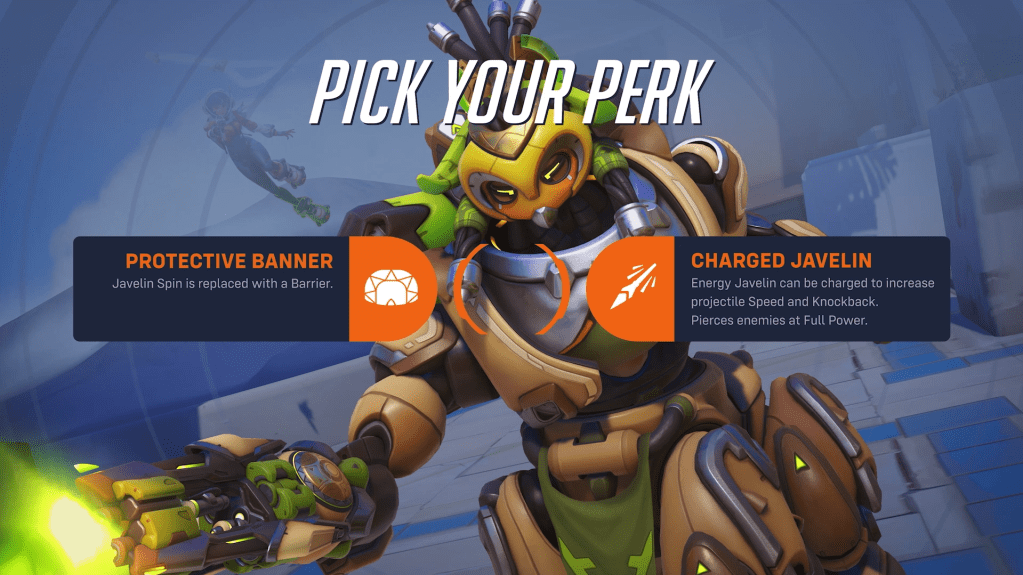
The first thing the Overwatch 2 team confirmed in their spotlight was the introduction of Perks, a development they’re calling the “most significant innovation to core gameplay” for Overwatch since the game launched in 2016. For players that have been around that long, and who have seen the shifts in the game’s dynamics and character changes, should know that they’re not playing around.
Perks will be given to players two times throughout a match, with one minor perk and one major perk. Players will be given these choices mid-game however and not between rounds, meaning the choice has to come to you quickly, though there’s not a time limit. The first perk, the minor one, is teased as being “Balanced but exciting” with potential upgrades being heat reduction for Orissa’s main weapon or a slight increase to Lucio’s soundwave ability.
Major perks on the other hand are much bigger in scope, with the dev team calling them
“powerful upgrades.” Torbjorn for example can be given the choice of letting his turret upgrade to level 3 when he activates Overload, or allow him to place his turret onto walls. Both have their advantages but again though it all comes down to choice, not only how YOU want to play but what you think works against the team that you’re facing.
According to Overwatch 2’s Lead Hero Designer Alec Dawson, the perk system came about because of a “need” for Overwatch to evolve as a game. Players will immediately recognize many of the perks as assets and abilities that have previously been in the games, among them: Torbjorn’s level 3 turret and Orissa’s barrier. One that almost made the cut was Symmetra’s shield generator from the earliest days of Overwatch. Considering the flexibility that the team is planning to impose on perks, it would still make the
cut one day.
“I think that will probably come back in some form,” Dawson said.
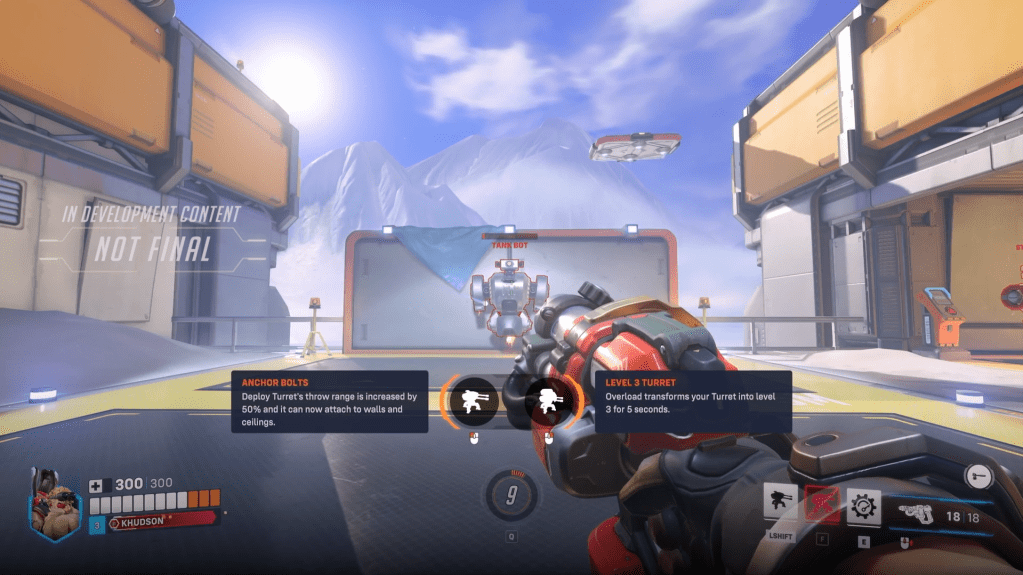
The threshold for when and how the team will take a perk out of the rotation and put a new one in its place can depend on a variety of factors. Ranging from what’s over performing to what’s under performing, plus what is and isn’t interesting to the player base. Player feedback was especially important in shaping the perks with one major Perk that has been added being a shift for Ramattra. When chosen, players will be able to make his Ravenous Vortex ability explode mid-air and then pull down flying heroes. This was designed and implemented specifically because of how the community views the ability and thinks it should function.
Choosing the various perks and how they would be implemented was driven by a major value, fulfilling the fantasy of playing that specific hero and how they should function in the player’s mind. Dawson noted that perks for heroes should be “Ambitious enough that things feel new.”
To his point, in our play test of the perk system the new wrinkles that they add to the game not only felt naturally to the rhythm of the matches and the progression of the characters but can at times offer exciting new ways to play. One such example was a game where we played the support character Lifeweaver, who we gave the minor perk of Cleansing Grasp, allowing the Life Grip ability to cleanse negative effects; and the major perk of Superbloom, which allows his thorn volley to detonate for an extra 30 damage when enough of them stick to a target within 1.5 seconds. These two perks not only give Lifeweaver even more dynamic support capabilities, but offensive prowess that he has been lacking since his introduction.
Though only two perks are available at launch with season 15, Dawson won’t rule out additional levels to the ability in the future. When asked if there was a potential for a Perk level 4, Dawson added: “Maybe! If it sticks around for a long time there will probably be Perks 2.0.”
RELATED: Overwatch 2: Every New Hero Perk Being Added to the Game
Overwatch 2’s 2025 Competitive Rework
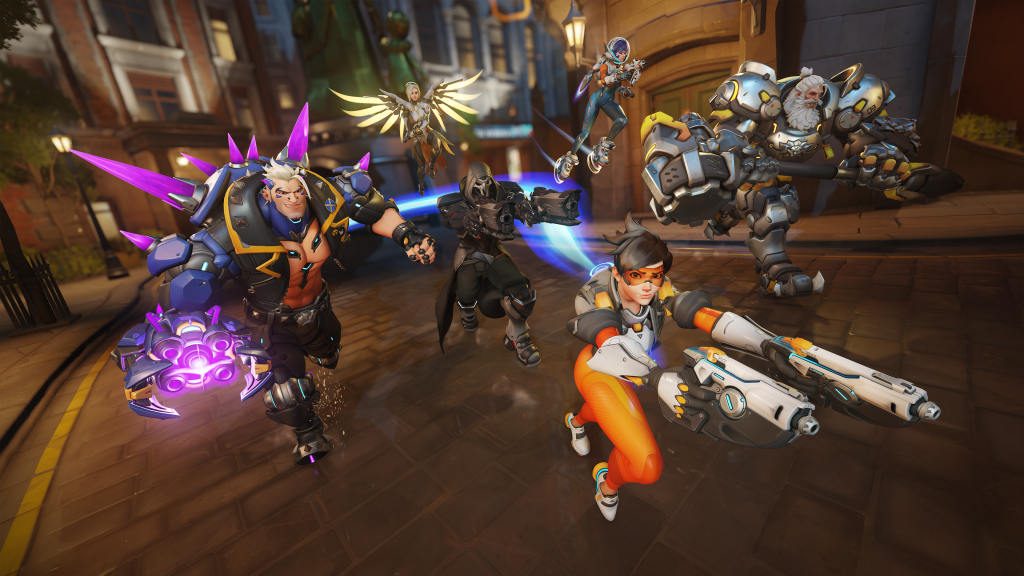
As they did previously with season 9 to kick start 2024, the Overwatch 2 team is gearing up for another rank reset in their competitive systems. Overwatch 2 will roll out new competitive rewards starting in season 15 including a brand new player weapon skin, Galactic Weapons. Taking over from last year’s Jade weapons, which will now be available as a “legacy weapon variant” and purchasable with the legacy competitive points (more on that soon). the Galactic weapon skins offer a purple hue that has depth to it like staring into the vastness of space. Players will also be given the option to trade in their current competitive points for legacy points immediately if they find that they have, say, 2000 legacy points and 1000 new points.
Additional competitive features confirmed to arrive in Overwatch 2’s competitive mode include Hero Bans, which will debut in Season 16 this April, and a Map Voting system, which was not given a specific release window. Senior Systems Designer Gavin Winter went into detail with us about how these will function after they’re rolled out, confirming that both hero bans and map voting will be a part of every level of Overwatch 2’s competitive play. This means that everyone playing from Bronze 5 up through Top 500 will not only vote on hero bans but vote on the maps they want to play.
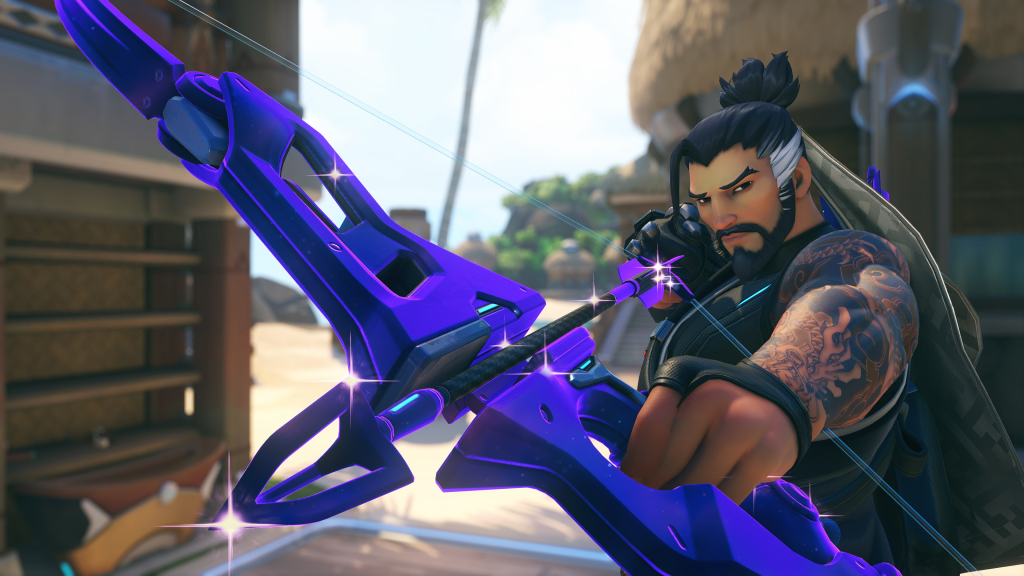
The way that hero bans will work in its current iteration (which was only explained to us and not shown visually) is each player will be given a ranked choice ballot where they can pick up to three characters that they want to ban. Teams will be able to communicate with each other to devise a strategy for what heroes they want out, but when voting on hero bans teams will NOT be able to see who they’re facing on the enemy team. If you faced a pesky Wrecking Ball main in your last game you’ll have no idea if they’re the same person you’re playing now, so ban Wrecking Ball at your own peril. Hero bans have long been a requested feature among the Overwatch 2 player base, with Winter confirming that the
size of the roster was largely a hurdle that kept them from implementing it sooner. Now that the game has more than forty heroes to choose from, it was time.
The map voting mechanics will present each team with three maps that they can play, with each player then selecting the map they want. It’s not as simple as the majority selecting King’s Row however, and could break down like this:
Say the three map choices are New Junk City, King’s Row, and Ilios. Each player will select
their map choice from the three. When the votes are collected the game will then take each vote, EG: 7 for King’s Row, 2 for Ilios, and 1 for New Junk City, and then select the map based on this weighting. In this example with 7 votes for King’s Row, it’s likely that this will be chosen, but the potential remains for New Junk City and the one player that picked it to get selected. Winter confirmed that the selection process is very similar to the track selection in Mario Kart 8 online, though one big difference will be that no one will know who voted for what map. If you’re the one player that picked the least popular map and it gets selected, no one will be aware that it was you. Keep your secret safe.
Winter noted that these two choices, which won’t both be incorporated into Competitive play until later, doesn’t extend time before gameplay very much. In fact the choices happen so quickly and are decided so fast that it doesn’t’ really effect game time too much. Regarding the pace of the choices before the game even began, Winter revealed that the team is happy with how fast it has ended up becoming.
Overwatch 2’s New Heroes in 2025
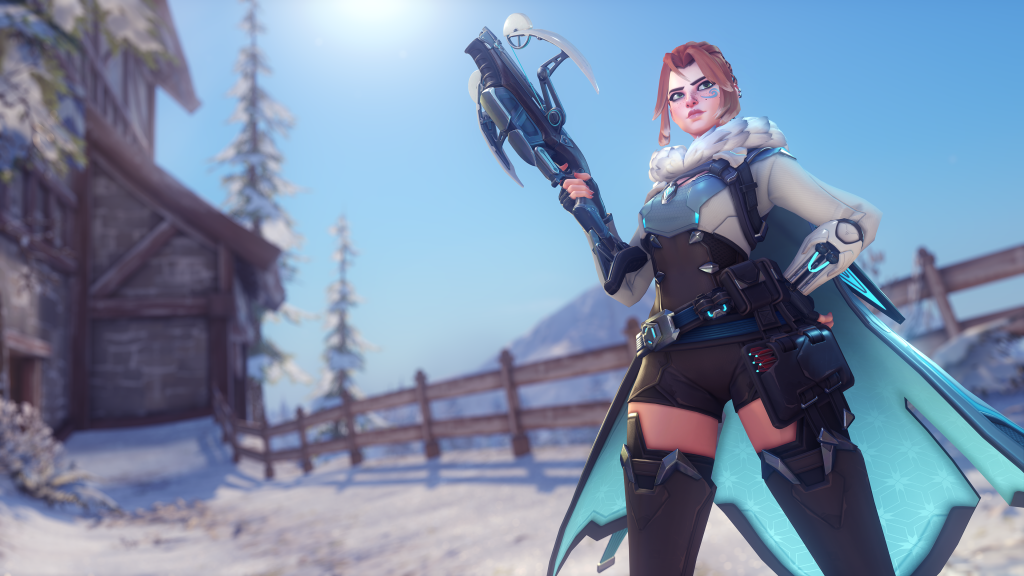
Overwatch 2 has also confirmed the next two heroes coming to the game. Season 16 of the game, due out in April, will see the release of Freya, a new DPS character. Hailing from Denmark, Freya was a part of the search and rescue team when Overwatch was still active, now years later she traverses the harsh land of her home as a bounty hunter. Senior narrative designer Jude Stacey noted that Freya’s relationship with a character like Ana will be considerably different from other former Overwatch agents. Though the likes of Reinhardt and Cassidy speak about her with reverence, Freya may not share that opinion.
Freya’s look, a caped bounty hunter with a crossbow, came about when Hudson joined the team and was given a folder of materials from an old art director with the specific piece of concept art that inspired her pre-dates Overwatch 1. From there her look was combined with the idea of her “slow-down ability,” which players can trigger when aiming down sight on her crossbow. From there the bounty hunter fantasy took hold and Freya’s kit came together quickly.
Freya has a high skill ceiling according to the Overwatch 2 team, and that was one of the main reasons they hoped to bring her into the game at this time. Hudson noted that they haven’t introduced a character like that, where a high skill players could excell due to a tough kit to master, since Echo was added in April of 2020. When players get their hands on Freya, with a play test intended to happen at some point in season 15, they’ll notice that her potential is very high. The Overwatch 2 team noted that their design philosophy of keeping new characters on the “safe side of strong” is key to how Freya will be when she arrives.
Blizzard also offered players a fresh tease of hero 44, a Chinese “water wielder” currently code named “Aqua.” No official details about their kit or their role in the game was revealed, but based on the concept art that was shown they appear to be something entirely new for the game and this universe.
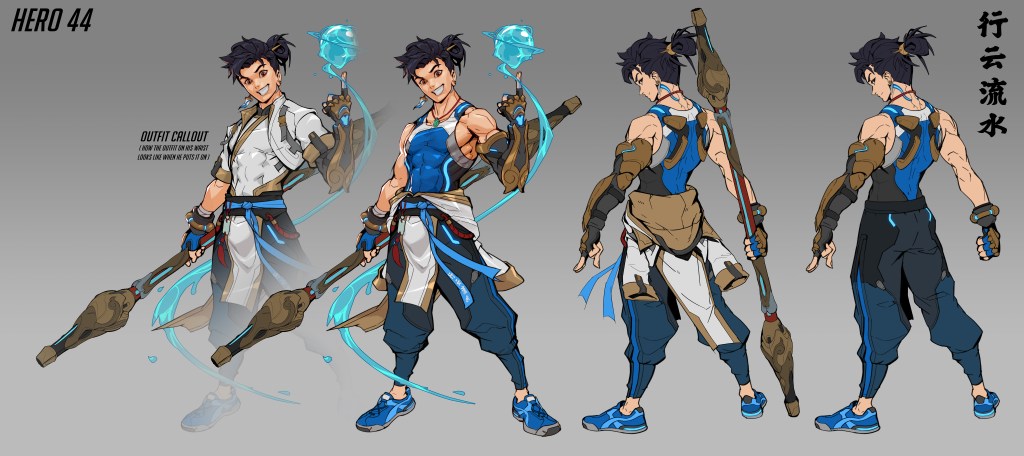
Players wondering if the frequency with which Marvel Rivals is rolling out new playable characters (a new one is set to arrive in that game every 45 days) may wonder if this is influencing how the Overwatch 2 team considers their own development pipeline. We asked the team if this was the case, and hero producer Kenny Hudson noted that they’re always in discussion about what’s best for the game and if a change of pace is needed. Of note however is the level of research and localization that goes into creating each hero and making them feel alive. Making the best hero they can takes time and Blizzard does not intend to compromise on quality and depth of research into new heroes
“We want all of these heroes to feel alive and relatable,” Hudson said.
Overwatch 2 fans may also be wondering if there remains any hope for an animated series set within the world of the game. The team noted that they remain “excited” about the potential to tell new stories across new mediums, but currently there remains nothing to share. Of note however, despite the PVE missions that were set to be a large part of Overwatch 2 no longer being in the pipeline, the team continues to talk about and consider the narrative choices that would have been made in those story missions and how they can incorporate them into the game.
Overwatch 2’s New Core Game Mode, Stadium

One of the most exciting announcements made during the Overwatch 2 spotlight was the reveal of the new Stadium mode. This new event combines not only multiple across different maps for a “best of 7” game mode, but incorporates character upgrades and builds along the way that players can fully customize to their liking. Overwatch 2 players that played limited time game modes like Junkenstein’s Laboratory back in October or the Mirrorwatch event may recognize some of the game shifting abilities that are at play.
What’s noteworthy about Stadium is that even though it sounds like a lot, and it is, the game rounds move very fast. Here’s how it works, players will queue based on their role and be given a limited pool of heroes to choose from, of the 40+ characters on the roster, the mode will launch with seventeen playable heroes. As each round begins players can choose from various upgrades to the hero ranging from the power and speed of a weapon or converting health into armor. Players will also be able to select new powers on every odd-numbered round, ranging from things like an extra swing of Junker Queen’s Carnage axe to Kiriko firing three kunai instead of just one.
It’s a tremendous amount of information that is thrown at the player all at once, and can be overwhelming. To combat this the team have come up with what they call a starter build tab, with two for each character, that offer handy guides for the kind of play style that players may want with their specific characters. Do you want a Soldier 76 build that is centered around your helix rockets? You can make it happen. Do you want to play DPS Moira and annihilate the enemy team? Fulfill it to your heart’s desire. For the development team, Stadium is all about maximizing the fantasy of playing each hero.
There are three major differences in Stadium when compared to the other core game modes of Quick Play or Competitive. First is that you play across multiple maps, though with some condensing. Across the 7 rounds you might play in a game of Stadium you’ll play just one of the three maps for a Control round, Ilios Ruins for example. Stadium will launch with just Clash, Push, and Control as the game modes that you’ll be able to play, with Push being limited to just the first checkpoint and Clash just the first to two points.
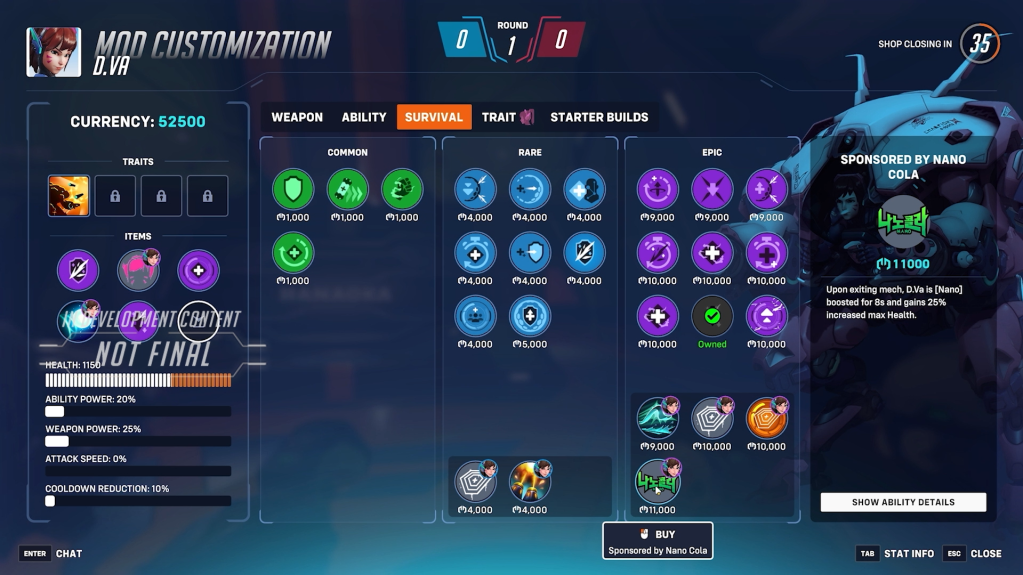
As for the second major difference, once a player has chosen their hero at the start of the game, they’re locked into that character until the end. Hero swapping has long been a key attribute of Overwatch gameplay, but where Stadium differs is by giving players the tools to outfit their characters in a way where they can counter someone like that would never be able to before. If you’re a support getting dived by a Genji, maximize your health and armor as the game progresses. If you’re a DPS that can’t escape a Reinhardt, give yourself lifesteal when doing damage to armor.
The third major difference of course is in the camera, as Stadium will default to giving players a third person view of their characters, though the option to switch to first person will be available if that is your preference. Naturally many will assume that this change, in this chaotic new mode is in response to Marvel Rivals. The dev team reiterated that Stadium has been in development in one form or another for over two years. In addition, the third person camera in Stadium wasn’t as simple as seeing a competitor utilize that specific look, and came more from a place of the game itself being so maximalist that it was beneficial for the player to have a wider view of the game and map so that they could actually see everything that was going on.
“We wanted to make something that was accessible to start,” Dylan Snyder, senior game designer revealed. “Easy to start, hard to master.”
Across each season, Stadium will not only add new heroes into the pool, but new build options for characters that were already available. An OP strategy that you might have had in season 16 (when Stadium launches) may no longer be on the table in season 17.
Season 15 of Overwatch 2, “Fortune and Glory,” will launch in the game on Tuesday, February 18th, bringing with it the new hero perks system, the new weapon variant and a host of fresh skins, plus the competitive rank reset. Season 16 of Overwatch 2 will launch in April, marking the arrival of the Stadium game mode and hero bans in Competitive.



